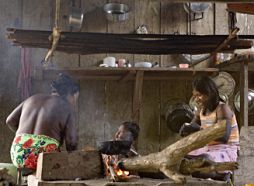Main content:
Clean Indoor Air

This is the 2007 draft on indoor air quality. You will get the newest version here.
Causes of indoor air pollution are cooking places with open fire, respectively the lack of access to modern energy.
Affected people and foundations of life: 2.4 billion people live in households in which women cook indoor using wood, dung, and other biomass. Another 0.6 billion use coal as well. An increase of numbers is expected. ( 2002, 69, 226; 2003.)
Deaths: 1.62 million people each year – primarily women and children (WHO 2002, 226).
Loss of healthy life-years: 38.5 million healthy life-years annually (; WHO 2002, 228).
Targets/goals: no international target.
Trend: ? no trend data available.
Measures: The most important interventions are better ventilation, more efficiently vented stoves, and cleaner fuels (WHO 2002, 70). Appropriate stoves for nearly half of the world population would cost about 30 billion (ITDG 2003). 112 governmental and non-governmental actors have joined together in the Partnership for Clean Indoor Air (www.pciaonline.org).
Annotations
For numeric names the short scale is used:
1 billion = one thousand million = 109 = 1 000 000 000
DALYs: Disability-adjusted life years.
One DALY represents the loss of one year of equivalent full health. DALYs are the sum of the years of life lost due to premature mortality (YLL) in the population and the years lost due to disability (YLD) for incident cases of the health condition. (WHO 2004, 95f.)
Sources
- ITDG 2003 – Intermediate Technology Development Group – article by Alex Kirby: Indoor smoke 'kills millions'. November 28, 2003.

- WHO 2002 – World Health Organization: The World Health Report 2002 – Reducing Risks, Promoting Healthy Life.
- WHO 2004 – World Health Organization: WHO Report 2004.


Draft (2007)
Photo credit: © UN Photo/Mark Garten
